DENKMALE DER MODERNE
Erfassung und Bewertung der Nachkriegsmoderne und jüngerer Zeitschichten

Geprägt von einem kollektiven Zukunftsglauben und bedingt durch ein rasantes Wirtschaftswachstum erlebten zahlreiche Staaten in den 1950er bis 1970er Jahren einen regelrechten Bauboom. Seinerzeit auch Ausdruck des jeweiligen politischen Systems, brachte diese rege Bautätigkeit einen umfassenden und vielfältigen Gebäudebestand hervor, der bis heute vielerorts stadt- und dorfbildprägend wirkt.
Mit der Kritik am ‚Baufunktionalismus‘ setzte in der Architektur und Stadtplanung ein Paradigmenwechsel ein. Seither führen Instandsetzungsbedarf und Modernisierungsabsichten, aber auch stadtpolitische Entscheidungen sowie wirtschaftliche Einzelinteressen zu überformenden Umbaumaßnahmen und Abrissen, womit die Nachkriegsmoderne als bauliche Zeitschicht zur Disposition steht.
Dabei ist heute sowohl die historische als auch baukulturelle Bedeutung vieler dieser Bauwerke in Fachkreisen bekannt und weitestgehend anerkannt. Dank der Inventarisation der Denkmalämter stehen bereits einige Bauten dieser Periode unter Denkmalschutz. Dieser Prozess ist jedoch noch längst nicht abgeschlossen. Der Forschungsbereich Denkmalpflege und Bauen im Bestand beschäftigt sich daher in Lehre und Forschung mit der Erfassung und Bewertung nachkriegsmoderner und jüngerer Bauten. Die Auseinandersetzung beschränkt sich dabei keinesfalls nur auf Wien und Österreich sowie auf herausragende und prominente Objekte, sodass bewusst auch europäische und außereuropäische sowie alltägliche und unscheinbarere Beispiele in den Blick genommen werden sollen.
Monuments of Modernism
Recording and evaluating post-war modernism and more recent layers of time
Characterised by a collective belief in the future and due to rapid economic growth, many countries experienced a veritable building boom from the 1950s till 1970s. At the time, this lively building activity was also an expression of the respective political system and resulted in a comprehensive and diverse building stock, which still has a formative effect on the towns and villages in many places today.
With the criticism of ‚building functionalism‘, a paradigm shift began in architecture and urban planning. Since then, the need for repair and modernisation, but also urban policy decisions and individual economic interests have led to overhauling conversion measures and demolitions, with the result that post-war modernism as an architectural period is up for grabs.
Despite this, the historical and cultural significance of many of these buildings is known and widely recognised among experts. Thanks to the inventories of the authorities, some buildings of this period are already listed. However, this process is far from complete. The research area of built heritage conservation and building in existing context is therefore concerned in teaching and research with the recording and evaluation of post-war modern and more recent buildings. The examination is by no means limited to Vienna and Austria or to outstanding and prominent objects, so that European and non-European as well as everyday and more inconspicuous examples are also taken into consideration.
